| Listing 1 - 10 of 10 |
Sort by
|
Book
ISBN: 2804141233 9782804141233 Year: 2002 Publisher: Brussel De Boeck Université
Abstract | Keywords | Export | Availability | Bookmark
 Loading...
Loading...Choose an application
- Reference Manager
- EndNote
- RefWorks (Direct export to RefWorks)
Biochimie --- Métabolisme --- Biochimie structurale --- 577.1 --- ATP adenosine triphosphate --- aminozuren --- biochemie --- enzymen --- glycolyse --- kinetica --- metabolisme --- proteïnen --- redoxreacties --- regulatie --- suikers --- thermodynamica --- .chemische basis van leven. biochemie en bio-organische chemie in het algemeen --- Métabolisme
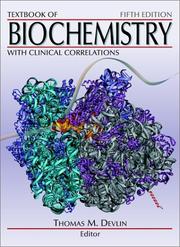
ISBN: 0471411361 9780471411369 Year: 2002 Publisher: New York, N.Y. Wiley
Abstract | Keywords | Export | Availability | Bookmark
 Loading...
Loading...Choose an application
- Reference Manager
- EndNote
- RefWorks (Direct export to RefWorks)
Pathological biochemistry --- klinische chemie --- medische biochemie --- Clinical chemistry --- Biochemistry --- Clinical biochemistry --- Cellule d'eucaryote --- eukaryotic cells --- Protéine --- proteins --- Enzymes --- Lipide --- Lipids --- Acide aminé --- Amino acids --- ADN --- DNA --- ARN --- RNA --- Métabolisme --- Metabolism --- Nutrition --- nutrition --- Physiologie humaine --- Human physiology --- DNA. --- RNA. --- nutrition.
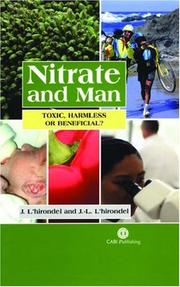
ISBN: 0851995667 9780851995663 Year: 2002 Publisher: Wallingford: CABI,
Abstract | Keywords | Export | Availability | Bookmark
 Loading...
Loading...Choose an application
- Reference Manager
- EndNote
- RefWorks (Direct export to RefWorks)
Nitrates --- Physiological effect. --- Toxicology. --- Nitrate --- Composition des aliments --- food composition --- Résidu --- residues --- Toxicité --- toxicity --- Santé publique --- public health --- Métabolisme de l'azote --- Nitrogen metabolism --- Fonction physiologique --- physiological functions --- Nitrates - Physiological effect. --- Nitrates - Toxicology.
Book
ISBN: 2804141241 9782804141240 Year: 2002 Publisher: Brussel De Boeck Université
Abstract | Keywords | Export | Availability | Bookmark
 Loading...
Loading...Choose an application
- Reference Manager
- EndNote
- RefWorks (Direct export to RefWorks)
ATP adenosine triphosphate --- glycoproteinen --- lipoproteïnen --- suikers --- Biochemistry --- 577.1 --- aminozuren --- biochemie --- enzymen --- fotosynthese --- kinetica --- metabolisme --- proteïnen --- redoxreacties --- regulatie --- thermodynamica --- .chemische basis van leven. biochemie en bio-organische chemie in het algemeen --- Biochemistry - examination questions
Book
ISSN: 02435624 ISBN: 2743004398 9782743004392 Year: 2002 Publisher: Paris : Éditions tec & doc,
Abstract | Keywords | Export | Availability | Bookmark
 Loading...
Loading...Choose an application
- Reference Manager
- EndNote
- RefWorks (Direct export to RefWorks)
Nutritionary hygiene. Diet --- Digestive System --- Food --- Digestive organs --- Aliments --- Appareil digestif --- Nutraceutiques --- Nutrition --- Aliment de régime --- Dietetic foods --- Fonction physiologique --- physiological functions --- Physiologie de la nutrition --- Nutrition physiology --- Nutrition humaine --- human nutrition --- Substance nutritive --- Nutrients --- Digestive system --- Métabolisme --- Metabolism --- Comportement du consommateur --- Consumer behaviour --- Technologie alimentaire --- Food technology --- Agrotechnology and Food Sciences. Food Sciences --- Food Product Design --- Food Product Design. --- Food. --- Digestive System.
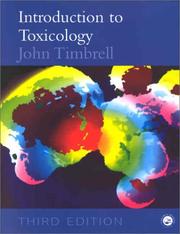
ISBN: 0415247624 0415247632 9780415247634 9786610402960 1280402962 0203361393 1420055992 1482203936 0367806592 1003016723 1000026965 Year: 2002 Publisher: London ; New York : Taylor & Francis,
Abstract | Keywords | Export | Availability | Bookmark
 Loading...
Loading...Choose an application
- Reference Manager
- EndNote
- RefWorks (Direct export to RefWorks)
Toxicology. --- Poisoning. --- Poisons. --- Agrotechnology and Food Sciences. Toxicology --- Toxicology (General) --- 615.9 --- geneeskunde --- geneesmiddelen --- metabolisme --- milieuverontreiniging --- oefeningen --- pathologie --- pesticiden --- toxicologie --- voedingsmiddelentoxicologie --- algemene toxicologie --- Toxicology (General). --- Toxicology --- Poisoning --- Poisons --- Poisonings --- Pharmaceutical Preparations --- Evidence Based Toxicology --- Evidence-Based Toxicology --- Toxinology --- Based Toxicologies, Evidence --- Based Toxicology, Evidence --- Evidence Based Toxicologies --- Evidence-Based Toxicologies --- Toxicologies, Evidence Based --- Toxicologies, Evidence-Based --- Toxicology, Evidence Based --- Toxicology, Evidence-Based --- Pharmacogenetics --- poisoning --- Poison

ISBN: 0849304601 Year: 2002 Publisher: Boca Raton CRC
Abstract | Keywords | Export | Availability | Bookmark
 Loading...
Loading...Choose an application
- Reference Manager
- EndNote
- RefWorks (Direct export to RefWorks)
Physiotherapy. Alternative treatments --- Social medicine --- stofwisseling --- sport --- sportgeneeskunde --- Adipose Tissue --- Exercise --- Adipose tissues --- Tissu adipeux --- metabolism. --- physiology. --- Metabolism. --- Physiological effects --- Métabolisme --- Aspect physiologique --- Physiological aspects. --- 612:796 --- -Exercise --- -Physical activity --- Warm-up --- Workouts (Exercise) --- Health --- Physical education and training --- Adipose tissue --- Body fat tissues --- Fat tissue --- Fatty tissue --- Connective tissues --- Fat --- Fysiologie van de sport --- Metabolism --- Physiological aspects --- -Fysiologie van de sport --- 612:796 Fysiologie van de sport --- -612:796 Fysiologie van de sport --- Physical activity --- Métabolisme --- Exercise physiology --- Clinical exercise physiology --- Physiological effect
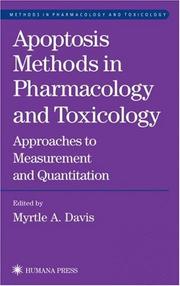
ISBN: 1280830646 9786610830640 1592592791 0896038904 Year: 2002 Publisher: Totowa, NJ : Humana Press : Imprint: Humana,
Abstract | Keywords | Export | Availability | Bookmark
 Loading...
Loading...Choose an application
- Reference Manager
- EndNote
- RefWorks (Direct export to RefWorks)
Apoptosis, or programmed cell death, is a widespread cellular process that regulates numerous important biological events ranging from the metamorphosis of the tadpole tail to the elimination of surplus brain cells in the formation of proper synaptic connections. In Apoptosis Methods in Pharmacology and Toxicology: Approaches to Measurement and Quantification, Dr. Myrtle A. Davis has assembled a panel of cutting-edge scientists to describe their best methods for detecting, illuminating, and quantifying apoptotic mechanisms in a way that is useful in toxicology and pharmacology research. These state-of-the-art techniques include flow cytometric, fluorometric, and laser scanning methods for quantifying and characterizing apoptosis, as well as protocols for the use of DNA microarray technology, high-throughput screens, and ELISA. Immunocytochemical methods for measuring biochemical and molecular endpoints in tissue sections will be highly useful for those carrying out studies in whole animal models as opposed to cell culture systems. Presented by authors well-versed in the technical problems and challenges in analyzing apoptosis, each method explicates its successful use, describes its limitations, and shows how it may be applied in large-scale screening operations. Concise and eminently practical, Apoptosis Methods in Pharmacology and Toxicology: Approaches to Measurement and Quantification offers pharmacologists, toxicologists, pathologists, and many other biomedical scientists today's gold standard reference source for methods that definitively identify and accurately quantify apoptosis.
Toxicology. --- Pharmacology/Toxicology. --- Chemicals --- Medicine --- Pharmacology --- Poisoning --- Poisons --- Toxicology --- Apoptosi --- Farmacologia --- Toxicologia --- Manuals de laboratori --- Tècniques de laboratori --- Dermatotoxicologia --- Immunotoxicologia --- Neurotoxicologia --- Toxicologia ambiental --- Toxicologia experimental --- Toxicologia industrial --- Toxicologia genètica --- Toxicologia pediàtrica --- Emmetzinament --- Intoxicació --- Verins --- Medicina --- Biofarmàcia --- Biotransformació (Metabolisme) --- Dermofarmacologia --- Desenvolupament de medicaments --- Estabilitat dels medicaments --- Farmacocinètica --- Farmacogenètica --- Farmacologia cardiovascular --- Farmacologia clínica --- Farmacologia dental --- Farmacologia geriàtrica --- Farmacologia molecular --- Farmacologia obstètrica --- Farmacologia ocular --- Farmacologia pediàtrica --- Farmacologia respiratòria --- Farmacologia renal --- Farmacologia veterinària --- Fotofarmacologia --- Immunofarmacologia --- Isòtops radioactius en farmacologia --- Neurofarmacologia --- Psicofarmacologia --- Química farmacèutica --- Radiofàrmacs --- Resistència als medicaments --- Medicaments --- Quimioteràpia --- Mort cel·lular
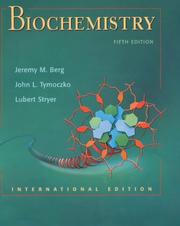
ISBN: 0716746840 0716730510 0716747383 9780716746843 Year: 2002 Publisher: New York Freeman
Abstract | Keywords | Export | Availability | Bookmark
 Loading...
Loading...Choose an application
- Reference Manager
- EndNote
- RefWorks (Direct export to RefWorks)
With new co-authors Jeremy Berg and John Tymoczko, "Biochemistry" 5th edition has expanded integration of evolution, more chemical and structural insights, and a web based media component created simultaneously with the text. Improved pedagogy includes: chapter opening outlines, expanded end of chapter problem sets, new types of problems, and special icons highlighting evolutionary coverage, clinically relevant material, or related media content on the Web. "Biochemistry" also becomes the first text to fully reflect the revolution that has taken place in biomedical science in the past ten years, culminating in the human genome project. A key focus of the new edition is the unifying features of protein structure and function that have been revealed by the incredible progress in gene sequencing. All molecular diagrams have been recreated by Jeremy Berg for clearer and more consistent presentations of structure throughout, with the art programme being increased by nearly 20 per cent over the previous edition. The new author team has also worked to maintain the book's defining feature: the characteristic clarity.
General biochemistry --- Biochemistry. --- 577.1 --- Chemical bases of life. Biochemistry and bio-organic chemistry generally --- 577.1 Chemical bases of life. Biochemistry and bio-organic chemistry generally --- Biochemistry --- Biochimie --- 577 --- antilichamen --- biochemie --- biologie --- biosynthese --- celfysiologie --- cytologie --- eiwitstructuur --- hemoglobine --- hormonale werking --- katabolisme --- membranen --- metabolisme --- moleculaire biologie --- nucleïnezuren --- proteïnen --- spierwerking --- virussen --- Biochemie --- antilichaam --- eiwit --- hormoon --- membraan --- proteine --- virus --- 577 Material bases of life. Biochemistry. Molecular biology. Biophysics --- Material bases of life. Biochemistry. Molecular biology. Biophysics --- .chemische basis van leven. biochemie en bio-organische chemie in het algemeen --- Biological chemistry --- Chemical composition of organisms --- Organisms --- Physiological chemistry --- Biology --- Chemistry --- Medical sciences --- Composition --- fotosynthese --- biochemistry --- celmembranen --- Biological Science Disciplines --- Natural Science Disciplines --- Disciplines and Occupations --- Human Anatomy & Physiology --- Health & Biological Sciences --- Animal Biochemistry --- Metabolic Diseases. --- Diseases, Metabolic --- Thesaurismosis --- Disease, Metabolic --- Metabolic Disease --- Thesaurismoses --- Metabolic Diseases
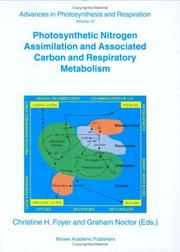
ISBN: 9780792363361 0792363361 9780306481383 0306481383 Year: 2002 Publisher: The Netherlands Kluwer Academic Publishers
Abstract | Keywords | Export | Availability | Bookmark
 Loading...
Loading...Choose an application
- Reference Manager
- EndNote
- RefWorks (Direct export to RefWorks)
According to many textbooks, carbohydrates are the photosynthesis and mitochondrial respiration fluctuate in a circadian manner in almost every unique final products of plant photosynthesis. However, the photoautotrophic production of organic organism studied. In addition, external triggers and environmental influences necessitate precise and nitrogenous compounds may be just as old, in appropriate re-adjustment of relative flux rates, to evolutionary terms, as carbohydrate synthesis. In the algae and plants of today, the light-driven assimilation prevent excessive swings in energy/resource provision of nitrogen remains a key function, operating and use. This requires integrated control of the alongside and intermeshing with photosynthesis and expression and activity of numerous key enzymes in respiration. Photosynthetic production of reduced photosynthetic and respiratory pathways, in order to carbon and its reoxidation in respiration are necessary co-ordinate carbon partioning and nitrogen assim- ation. to produce both the energy and the carbon skeletons required for the incorporation of inorganic nitrogen This volume has two principal aims. The first is to into amino acids. Conversely, nitrogen assimilation provide a comprehensive account of the very latest developments in our understanding of how green is required to sustain the output of organic carbon cells reductively incorporate nitrate and ammonium and nitrogen. Together, the sugars and amino acids into the organic compounds required for growth.
Nitrogen --- Plants --- Photosynthesis. --- Azote --- Plantes --- Plantes, Effets du carbone sur les --- Photosynthèse --- Metabolism. --- Assimilation. --- Effect of carbon on. --- Respiration. --- Métabolisme --- Assimilation --- Nitrogen -- Metabolism. --- Plants -- Assimilation. --- Plants -- Effect of carbon on. --- Plants -- Respiration. --- Photosynthesis --- Botany --- Earth & Environmental Sciences --- Plant Physiology --- Metabolism --- Effect of carbon on --- Respiration --- Life sciences. --- Biochemistry. --- Plant physiology. --- Biophysics. --- Biological physics. --- Life Sciences. --- Plant Physiology. --- Biochemistry, general. --- Biophysics and Biological Physics. --- Biological and Medical Physics, Biophysics. --- Plant respiration --- Plant physiology --- Gases from plants --- Plants, Effect of carbon on --- Carbon --- Assimilation (Botany) --- Minerals in plants --- Plant assimilation --- Phytoliths --- Photobiology --- Effect of anaerobiosis on --- Physiological effect --- Effect of chemicals on --- Effect of light on --- Photorespiration --- Biological physics --- Biology --- Medical sciences --- Physics --- Biological chemistry --- Chemical composition of organisms --- Organisms --- Physiological chemistry --- Chemistry --- Physiology --- Composition
| Listing 1 - 10 of 10 |
Sort by
|

 Search
Search Feedback
Feedback About
About Help
Help News
News